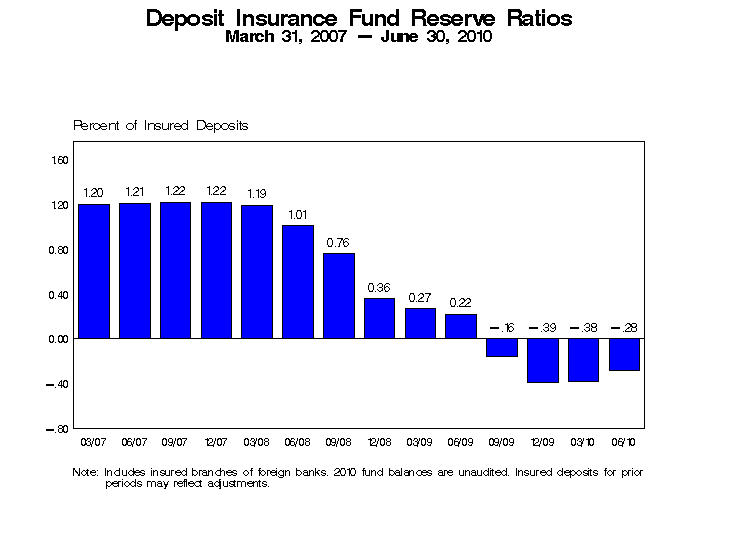October 19, 2010 – The FDIC announced today a long term Restoration Plan to return the Deposit Insurance Fund (DIF) to a positive balance. The long term goal of the proposed fund management plan is to maintain a positive fund balance, even “during periods of large fund losses, and maintaining steady, predictable assessment rates throughout economic and credit cycles”.
There were 272 banking failures during 2009 and 2010, the highest number of failures since 1992. Large losses on failed banks over the past two years has completely depleted the FDIC Deposit Insurance Fund. At June 30, 2010, the DIF had a negative fund balance of $15.2 billion, despite a special FDIC assessment of $46 billion collected from insured institutions at the end of 2009. In addition, earlier this year the FDIC projected that the cost of resolving additional banking failures over the next four years would be approximately $100 billion.
The recently passed Dodd-Frank Act requires that the FDIC Deposit Insurance Fund reaches a fund reserve ratio of 1.35% by September 30, 2020. The Restoration Plan foregoes a sheduled increase of 3 basis points in the assessment rate that was to go into effect on January 1, 2011. The decision to cancel the scheduled assessment rate increase was based on an updated FDIC analysis forecasting a slight decrease in losses through 2014.
The FDIC also proposed establishing a designated reserve ratio of 2% and an average assessment rate of 8.5 basis points. The FDIC proposal is based on a historical analysis by the FDIC showing that to maintain a positive fund balance and predictable assessment rates, the reserve ratio should be at least 2% prior to a period of large fund losses.
By establishing a fund balance large enough to cover future projected losses during an economic downturn, the banking industry will avoid being hit with large additional assessments at a time they are least likely to afford the payments. Current assessment rates on insured deposits held by banks vary based on the risk category assigned to the bank, type of deposits and whether the bank has been insured for less than five years.
If the new FDIC plan is successful and the insurance fund is restored to levels than can handle hundreds of banking failures, confidence in the banking and financial system should be enhanced greatly.
FDIC Chairman Bair, commenting on the new proposals stated that:
“I am pleased that we are able to provide some assessment rate relief now in light of our lower loss projections. While it is difficult to make long-term projections, we are trying to give the industry greater certainty regarding what rates will be over the long run. The trade off we are proposing is lower, more stable and predictable premiums, but a higher reserve.”
“I believe that in both the long and the short run, these proposals will benefit the banking industry, the fund and the financial system. Just like the last financial crisis, memories will quickly fade as we move further away from the fall of 2008 and the need for a strong fund will become less obvious. That’s why I consider the Board’s action today to be crucial, while the need for a sufficiently large fund and stable premiums is most apparent. Our action now will establish standards for sound fund management for a long time to come and better position the FDIC to resist future calls to reduce assessment rates or pay large dividends at the expense of prudent fund management.”

Speak Your Mind
You must be logged in to post a comment.